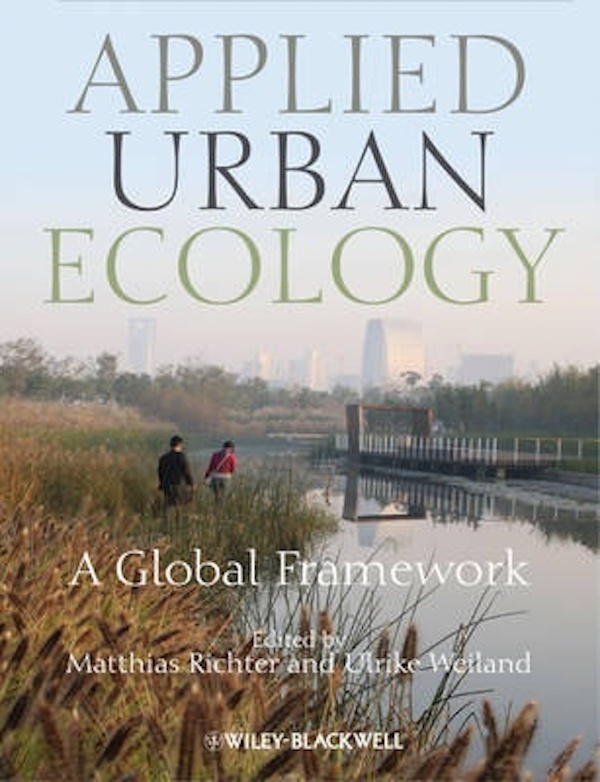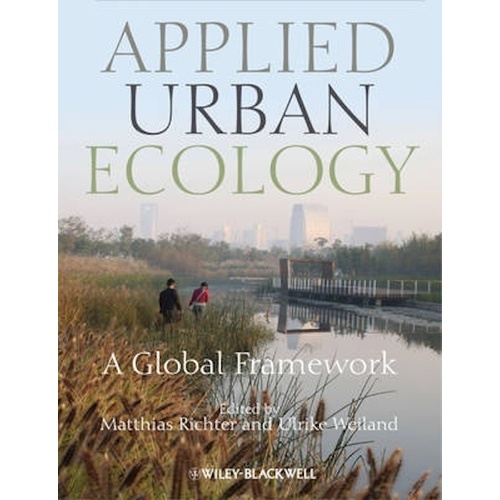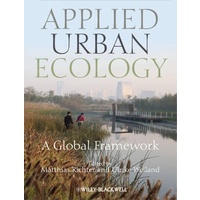Applied Urban Ecology - a Global Framework
Author: Ulrike Weiland Matthias RichterPublisher: Wiley-Blackwell (an imprint of John Wiley & Sons Ltd)Category: Ecological Science, The BiosphereBook Format: PaperbackApplied Urban Ecology: A Global Framework explores ways in which the environmental quality of urban areas can be improved starting with existing environmental conditions and their dynamics. Written by an internationally renowned selection of scientists and practitioners, the book covers a broad range of established and novel approaches to applied urban ecology. Approaches chosen for the book are placed in the context of issues such as climate change, green- and open-space development, flood-risk assessment, threats to urban biodiversity, and increasing environmental pollution (especially in the megacities of newly industrialized countries). All topics covered were chosen because they are socially and socio-politically relevant today. Further topics covered include sustainable energy and budget management, urban water resource management, urban land management, and urban landscape planning and design. Throughout the book, concepts and methods are illustrated using case studies from around the world. A closing synopsis draws conclusions on how the findings of urban ecological research can be used in strategic urban management in the future. Applied Urban Ecology: A Global Framework is an advanced textbook for students, researchers and experienced practitioners in urban ecology and urban environmental research, planning, and practice.
Matthias Richter, Environmental Scientist, Publicist and University Lecturer, Germany. Ulrike Weiland is Professor of Urban Ecology at the Institute for Geography, University of Leipzig, Germany.
List of contributors, xi Foreword, xiii PART I: INTRODUCTION, 1 1. Urban ecology - brief history and present challenges, 3 Ulrike Weiland andMatthias Richter 1.1 Introduction, 3 1.2 Brief history, 3 1.3 Recent and present challenges, 5 1.4 Purpose and structure of the book, 7 References, 9 PART II: URBAN ECOLOGY: RELATED DISCIPLINES AND METHODS, 13 2. Thematic-methodical approaches to applied urban ecology, 15 Matthias Richter and UlrikeWeiland 3. Monitoring urban land use changes with remote sensing techniques, 18 Ellen Banzhaf andMaik Netzband 3.1 Land use changes and their consequences for urban ecology, 18 3.2 Urban remote sensing (URS) and geographical information systems (GIS) for research in urban ecology, 19 3.3 Measuring physical characteristics of urban areas with remote sensing technology, 21 3.4 Global initiatives to measure urban expansion and land use change, 24 3.5 Regional urban monitoring activities, 26 3.6 Synthesis and outlook, 29 References, 30 PART III: SELECTED FIELDS OF URBAN ECOLOGY, 33 A. PATHWAYS OF THE ECOSYSTEM APPROACH. 4. Quantifying spatiotemporal patterns and ecological effects of urbanization: a multiscale landscape approach, 35 Jianguo Wu, Alexander Buyantuyev, G. Darrel Jenerette, Jennifer Litteral, Kaesha Neil and Weijun Shen 4.1 Introduction, 35 4.2 Characterizing the spatiotemporal pattern of urbanization, 36 4.3 Simulating spatiotemporal dynamics of urbanization, 41 4.4 Effects of urbanization on biodiversity and ecosystem processes: examples from CAP-LTER, 43 4.5 Concluding remarks, 47 Acknowledgments, 49 References, 49 5. Designing urban systems: ecological strategies with stocks and flows of energy and material, 54 Peter Baccini 5.1 The challenge of a new urbanity, 54 5.2 Urban systems and their resource management, 56 5.3 Strategies of reconstruction, 60 5.4 Developing strategies for the design of urban systems, 63 References, 65 B. SOCIOENVIRONMENTAL THREATS. 6. Environmental and ecological threats in Indian mega-cities, 66 Surinder Aggarwal and Carsten Butsch 6.1 Urbanization dynamics and emergence of mega-cities, 66 6.2 Environmental threats, 68 6.3 Mega-social challenges, 74 6.4 Concluding remarks, 78 Acknowledgments, 80 References, 80 7. From wasteland to wilderness - aspects of a new form of urban nature, 82 Dieter Rink and Harriet Herbst 7.1 Introduction, 82 7.2 Urban wilderness - some attempts at defining the term, 83 7.3 Wastelands as a source of urban wilderness, 83 7.4 Urban wilderness in planning, 85 7.5 On the ecology of urban wilderness, 86 7.6 Urban wilderness in a social context, 87 7.7 Educational value of urban wilderness, 89 7.8 Conclusions, 90 References, 91 C. FLOODING AND CLIMATE ADAPTATION. 8. Multiscale flood risk assessment in urban areas - a geoinformatics approach, 93 Norman Kerle and Dinand Alkema 8.1 Introduction, 93 8.2 Flood risk in the context of urban ecology, 94 8.3 Comprehensive flood risk assessment - Naga City, the Philippines, 96 8.4 The role of remote sensing in flood risk assessment and management, 99 8.5 Disaster risk in the context of urban ecology - an outlook, 104 References, 104 9. Urban open spaces and adaptation to climate change, 106 Marialena Nikolopoulou 9.1 Cities, climate change and the role of open spaces, 106 9.2 Outdoor comfort, 107 9.3 Use of space, 108 9.4 Thermal perception, 111 9.5 Adaptation, 113 9.6 Design interventions, 116 9.7 Conclusions, 120 References, 121 D. URBAN BIODIVERSITY. 10. Social aspects of urban ecology in developing countries, with an emphasis on urban domestic gardens, 123 Sarel Cilliers, Stefan Siebert, Elandrie Davoren and Rina Lubbe 10.1 Introduction, 123 10.2 Social benefits and human perceptions of urban green areas, 124 10.3 Consequences of socioeconomic aspects on the urban green infrastructure, 125 10.4 Urban domestic gardens, 126 10.5 Conclusions, 133 References, 135 11. Plant material for urban landscapes in the era of globalization: roots, challenges and innovative solutions, 139 Maria Ignatieva 11.1 Introduction, 139 11.2 The beginning of plant material globalization, 139 11.3 Victorian Gardenesque (1820-1880), 140 11.4 Influence of the Victorian garden on the global planting pattern, 142 11.5 Victorian tropical and subtropical paradise, 143 11.6 Modern nurseries' direction: global pool of plants, 145 11.7 Innovative solutions: searching for new ecological planting design, 148 11.8 Discussion and conclusion, 150 Acknowledgments, 150 References, 150 E. ENVIRONMENTAL URBAN DESIGN. 12. Ecological infrastructure leads the way: the negative approach and landscape urbanism for smart preservation and smart growth, 152 Kongjian Yu 12.1 Introduction, 152 12.2 The negative approach: methodology, 158 12.3 Urban growth based on EI: a case of negative planning for Taizhou City, 159 12.4 Conclusion, 165 References, 166 13. Integrating science and creativity for landscape planning and design of urban areas, 170 Antje Stokman and Christina von Haaren 13.1 Introduction, 170 13.2 Landscape planning as a legally based contribution to sustainable development in Germany, 171 13.3 Landscape design as a creative cultural action, 173 13.4 Linking landscape planning and design: differences, interfaces and potential synergies, 175 13.5 Conclusion, 182 Acknowledgment, 183 References, 183 14. Landscape as a living system: Shanghai 2010 Expo Houtan Park, 186 Kongjian Yu 14.1 Introduction, 186 14.2 Objective, 186 14.3 Challenges, 186 14.4 Design concept and strategy: a living system, 188 14.5 Conclusions, 192 F. ENVIRONMENTAL URBAN POLITICS. 15. Geographical perspectives on a radical political ecology of water, 193 Alex Loftus 15.1 Introduction, 193 15.2 The urbanization of nature, 194 15.3 Urban political ecologies of water, 195 15.4 Privatization questions, 196 15.5 Taking the debates forward, 199 15.6 Infrastructures of power: democratizing water technologies, 199 15.7 The everyday, 201 15.8 Conclusions, 202 References, 202 PART IV: SYNTHESIS, 205 16. Synthesizing urban ecology research and topics for urban environmental management, 207 Matthias Richter and UlrikeWeiland Index, 213
Table Of Contents
List of contributors, xi Foreword, xiii PART I: INTRODUCTION, 1 1. Urban ecology brief history and present challenges, 3 Ulrike Weiland andMatthias Richter 1.1 Introduction, 3 1.2 Brief history, 3 1.2.1 Initials in urban natural history, 3 1.2.2 Socioecological tradition, 4 1.2.3 Complex bioecological tradition, 4 1.2.4 Ecosystem-related tradition, 4 1.3 Recent and present challenges, 5 1.4 Purpose and structure of the book, 7 1.4.1 Purpose of the book, 7 1.4.2 Structure of the book, 8 References, 9 PART II: URBAN ECOLOGY: RELATED DISCIPLINES AND METHODS, 13 2. Thematic methodical approaches to applied urban ecology, 15 Matthias Richter and UlrikeWeiland 3. Monitoring urban land use changes with remote sensing techniques, 18 Ellen Banzhaf andMaik Netzband 3.1 Land use changes and their consequences for urban ecology, 18 3.2 Urban remote sensing (URS) and geographical information systems (GIS) for research in urban ecology, 19 3.3 Measuring physical characteristics of urban areas with remote sensing technology, 21 3.3.1 Effects of urban form on natural and man-made hazards, 21 3.3.2 Urban dynamics and ecosystem function, 23 3.4 Global initiatives to measure urban expansion and land use change, 24 3.4.1 Global Urban Observatory of UN-HABITAT, 24 3.4.2 "The Dynamics of Global Urban Expansion" a contribution by theWorld Bank, 24 3.4.3 Socioeconomic data and applications Center (SEDAC) at the Center for International Earth Science Information Network (CIESIN), Columbia University, New York, USA, 25 3.4.4 The "100 Cities Project", Arizona State University, USA, 26 3.5 Regional urban monitoring activities, 26 3.5.1 Europe: ESPON, MOLAND and the Urban Atlas, 26 3.5.2 Governmental research projects on urban growth in the United States, 29 3.6 Synthesis and outlook, 29 References, 30 PART III: SELECTED FIELDS OF URBAN ECOLOGY, 33 A. PATHWAYS OF THE ECOSYSTEM APPROACH. 4. Quantifying spatiotemporal patterns and ecological effects of urbanization: a multiscale landscape approach, 35 Jianguo Wu, Alexander Buyantuyev, G. Darrel Jenerette, Jennifer Litteral, Kaesha Neil and Weijun Shen 4.1 Introduction, 35 4.2 Characterizing the spatiotemporal pattern of urbanization, 36 4.2.1 Quantifying urbanization patterns with landscape metrics, 36 4.2.2 Other methods for quantifying urban landscape pattern, 39 4.2.3 Effects of scale on the analysis of urban landscape patterns, 39 4.2.4 Examples from CAP-LTER, 40 4.3 Simulating spatiotemporal dynamics of urbanization, 41 4.3.1 Importance of simulation models in urban studies, 41 4.3.2 Approaches to simulating urban dynamics, 41 4.3.3 Examples from CAP-LTER, 42 4.4 Effects of urbanization on biodiversity and ecosystem processes: examples from CAP-LTER, 43 4.4.1 Effects of urbanization on biodiversity, 43 4.4.2 Effects of urbanization on soil biogeochemical patterns, 44 4.4.3 Effects of urbanization on net primary production, 45 4.4.4 Effects of urbanization on vegetation phenology, 45 4.4.5 Urban heat islands and ecological effects, 46 4.4.6 Ecosystem responses to urbanization-induced environmental changes, 46 4.5 Concluding remarks, 47 Acknowledgments, 49 References, 49 5. Designing urban systems: ecological strategies with stocks and flows of energy and material, 54 Peter Baccini 5.1 The challenge of a new urbanity, 54 5.2 Urban systems and their resource management, 56 5.2.1 Methodology applied investigating resource management of complex systems, 56 5.2.2 Relevant differences between agrarian and urban systems on a regional scale, 56 5.2.3 The resource management perspectives on a global scale, 58 5.2.4 The essential mass resources in the development of urban regions, 59 5.3 Strategies of reconstruction, 60 5.3.1 The 2000 watt society, 60 5.3.2 Transformation of urban regions in a "time of safe practice", 61 5.3.3 The exploration of urban stocks, 61 5.4 Developing strategies for the design of urban systems, 63 References, 65 B. SOCIOENVIRONMENTAL THREATS. 6. Environmental and ecological threats in Indian mega-cities, 66 Surinder Aggarwal and Carsten Butsch 6.1 Urbanization dynamics and emergence of mega-cities, 66 6.2 Environmental threats, 68 6.2.1 Environmental threats from waste water and sewerage disposal, 68 6.2.2 Deteriorating air quality, 69 6.2.3 Urban wastemismanagement and environmental degradation, 71 6.2.4 Ecosystem damages and ecological footprints, 72 6.2.5 Threats from natural hazards, disasters, and climate change, 73 6.3 Mega-social challenges, 74 6.3.1 Poverty and fragmentation, 75 6.3.2 Rising vulnerabilities and insecurities, 76 6.3.3 Inequities and inequalities in urban services, 77 6.4 Concluding remarks, 78 Acknowledgments, 80 References, 80 7. From wasteland to wilderness aspects of a new form of urban nature, 82 Dieter Rink and Harriet Herbst 7.1 Introduction, 82 7.2 Urban wilderness some attempts at defining the term, 83 7.3 Wastelands as a source of urban wilderness, 83 7.4 Urban wilderness in planning, 85 7.5 On the ecology of urban wilderness, 86 7.6 Urban wilderness in a social context, 87 7.7 Educational value of urban wilderness, 89 7.8 Conclusions, 90 References, 91 C. FLOODING AND CLIMATE ADAPTATION. 8. Multiscale flood risk assessment in urban areas a geoinformatics approach, 93 Norman Kerle and Dinand Alkema 8.1 Introduction, 93 8.2 Flood risk in the context of urban ecology, 94 8.3 Comprehensive flood risk assessment Naga City, the Philippines, 96 8.3.1 Floods in Naga, 96 8.3.2 Naga's flood management practices, 97 8.3.3 Model-based flood scenario studies, 97 8.3.4 Linking flood modeling with disaster management, 98 8.3.5 Naga as example for other flood-prone cities, 99 8.4 The role of remote sensing in flood risk assessment and management, 99 8.4.1 Quasistatic hazard data, 100 8.4.2 Dynamic hazard data, 101 8.4.3 Mapping elements at risk, 102 8.5 Disaster risk in the context of urban ecology an outlook, 104 References, 104 9. Urban open spaces and adaptation to climate change, 106 Marialena Nikolopoulou 9.1 Cities, climate change and the role of open spaces, 106 9.2 Outdoor comfort, 107 9.3 Use of space, 108 9.3.1 Seasonal profile, 108 9.3.2 Diurnal profile, 108 9.4 Thermal perception, 111 9.5 Adaptation, 113 9.5.1 Physical adaptation, 113 9.5.2 Psychological adaptation, 113 9.6 Design interventions, 116 9.6.1 Materials, 117 9.6.2 Vegetation, 118 9.6.3 Shading, 118 9.6.4 Water, 119 9.6.5 Other measures, 119 9.7 Conclusions, 120 References, 121 D. URBAN BIODIVERSITY. 10. Social aspects of urban ecology in developing countries, with an emphasis on urban domestic gardens, 123 Sarel Cilliers, Stefan Siebert, Elandrie Davoren and Rina Lubbe 10.1 Introduction, 123 10.2 Social benefits and human perceptions of urban green areas, 124 10.3 Consequences of socioeconomic aspects on the urban green infrastructure, 125 10.4 Urban domestic gardens, 126 10.4.1 Literature review, 126 10.4.2 Case studies from the North-West Province, South Africa, 128 10.5 Conclusions, 133 References, 135 11. Plant material for urban landscapes in the era of globalization: roots, challenges and innovative solutions, 139 Maria Ignatieva 11.1 Introduction, 139 11.2 The beginning of plant material globalization, 139 11.3 Victorian Gardenesque (1820 1880), 140 11.4 Influence of the Victorian garden on the global planting pattern, 142 11.5 Victorian tropical and subtropical paradise, 143 11.6 Modern nurseries direction: global pool of plants, 145 11.7 Innovative solutions: searching for new ecological planting design, 148 11.7.1 Europe: United Kingdom, 148 11.7.2 Europe: The Netherlands, 148 11.7.3 Europe: Germany, 148 11.7.4 United States, 149 11.7.5 New Zealand: modern approach to planting design, 149 11.8 Discussion and conclusion, 150 Acknowledgments, 150 References, 150 E. ENVIRONMENTAL URBAN DESIGN. 12. Ecological infrastructure leads the way: the negative approach and landscape urbanism for smart preservation and smart growth, 152 Kongjian Yu 12.1 Introduction, 152 12.1.1 Urbanization in China challenges survival, 152 12.1.2 The failure of the conventional approach in urban development planning, 153 12.1.3 Green infrastructure leads the way: the negative approach and landscape urbanism, 154 12.2 The negative approach: methodology, 158 12.2.1 Process analysis, 158 12.2.2 Defining landscape security patterns, 159 12.2.3 Defining ecological infrastructure, 159 12.2.4 Defining urban form at the large scale: urban growth alternatives based on regional EI, 159 12.2.5 Defining urban form at the intermediate scale: urban open spaces system based on EI, 159 12.2.6 Defining urban form at the small scale: site-specific urban development alternatives based on EI, 159 12.3 Urban growth based on EI: a case of negative planning for Taizhou City, 159 12.3.1 Critical landscape processes, 161 12.3.2 Defining landscape security patterns for the targeted processes, 162 12.3.3 Defining ecological infrastructure, 164 12.3.4 Scenarios of urban growth pattern based on the regional ecological infrastructure, 164 12.3.5 Shaping urban form at the intermediate scale, 165 12.3.6 Shaping urban land development at the small scale, 165 12.4 Conclusion, 165 References, 166 13. Integrating science and creativity for landscape planning and design of urban areas, 170 Antje Stokman and Christina von Haaren 13.1 Introduction, 170 13.2 Landscape planning as a legally based contribution to sustainable development in Germany, 171 13.2.1 Tasks of landscape planning, 171 13.2.2 Methodologies of landscape planning, 172 13.3 Landscape design as a creative cultural action, 173 13.3.1 Tasks of landscape design, 173 13.3.2 Methodologies of landscape design, 174 13.4 Linking landscape planning and design: differences, interfaces and potential synergies, 175 13.4.1 A matter of timeline and scale: linking multidimensional perspectives on strategic landscape development, 175 13.4.2 A matter of perception and meaning: linking environmental goals and cultural concepts, 176 13.4.3 A matter of process and learning: linking management and experimentation to achieve adaptive landscape development, 178 13.4.4 A matter of involvement and experience: linking information and participation, 181 13.5 Conclusion, 182 Acknowledgment, 183 References, 183 14. Landscape as a living system: Shanghai 2010 Expo Houtan Park, 186 Kongjian Yu 14.1 Introduction, 186 14.2 Objective, 186 14.3 Challenges, 186 14.3.1 Pollution, 186 14.3.2 Flooding, 186 14.3.3 Circulation, 187 14.3.4 Transformation, 187 14.3.5 Identity, 187 14.3.6 Form, 188 14.4 Design concept and strategy: a living system, 188 14.4.1 Ecological landscape, 189 14.4.2 Three dimensions of meanings, 190 14.4.3 Experience network, 191 14.5 Conclusions, 192 F. ENVIRONMENTAL URBAN POLITICS. 15. Geographical perspectives on a radical political ecology of water, 193 Alex Loftus 15.1 Introduction, 193 15.2 The urbanization of nature, 194 15.3 Urban political ecologies of water, 195 15.4 Privatization questions, 196 15.5 Taking the debates forward, 199 15.6 Infrastructures of power: democratizing water technologies, 199 15.7 The everyday, 201 15.8 Conclusions, 202 References, 202 PART IV: SYNTHESIS, 205 16. Synthesizing urban ecology research and topics for urban environmental management, 207 Matthias Richter and UlrikeWeiland Index, 213About Matthias Richter
Matthias Richter, Environmental Scientist, Publicist and University Lecturer, Germany. Ulrike Weiland is Professor of Urban Ecology at the Institute for Geography, University of Leipzig, Germany.| SKU | BK-9781444333404 |
| Barcode # | 9781444333404 |
| Brand | Wiley-Blackwell (an imprint of John Wiley & Sons L |
| Artist / Author | Ulrike Weiland Matthias Richter |
| Shipping Weight | 0.5700kg |
| Shipping Width | 0.190m |
| Shipping Height | 0.010m |
| Shipping Length | 0.250m |
| Assembled Length | 24.500m |
| Assembled Height | 1.400m |
| Assembled Width | 18.800m |
| Type | Paperback |




